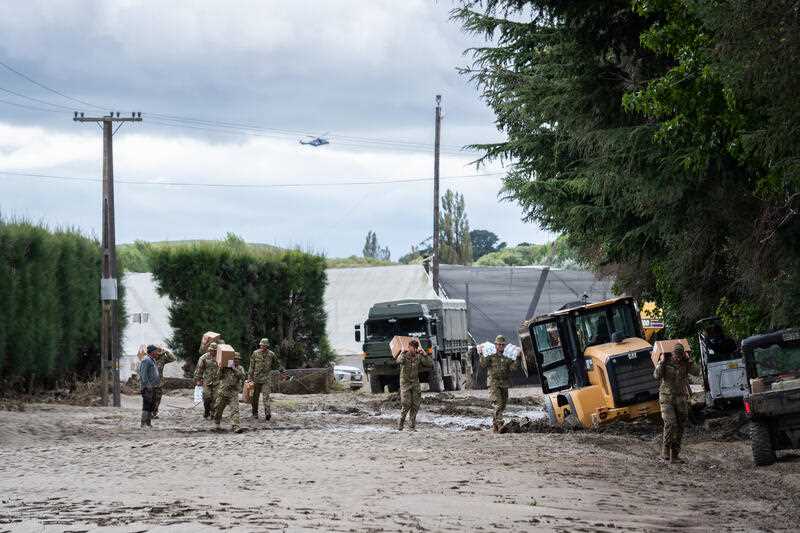The New Zealand government expects Cyclone Gabrielle to come with a bill of more than $10 billion ($A9.1 billion), rivalling the costs of the 2011 Christchurch earthquakes.
Foreign Minister Grant Robertson has foreshadowed a complete re-write of the budget, due in May, to factor in the long, costly recovery from the storm.
A week after Gabrielle first brought gale-force winds to New Zealand, authorities are still coming to grips with the magnitude of its destruction.
The death toll stands at 11 but authorities expect it to grow.
Large swathes of the North Island have been severely impacted by the cyclone, from the northernmost region of Northland to the Wairarapa, to Wellington’s east.
Mr Robertson told TVNZ the government appreciated the scale of the crisis.
“It’s going to be the biggest weather-related event this century and it will have a multi-billion dollar price tag,” he said.
“(The) Canterbury (2011 earthquakes) was up in that sort of $13 billion ($A12 billion) area.
“That’s around the ballpark that we’re looking at right now in terms of the costs, but each day we discover more. Each day we understand more.”
Land and infrastructure have been damaged across the North Island.
Hawke’s Bay has fared the worst, with whole valleys used for horticulture and viticulture now caked in silt, the remnants of overflowing rivers and floods.
In Hawke’s Bay, Northland, the Coromandel, the Gisborne-Tairawhiti region and to the west of Auckland, parts of the road network, including bridges, will require complete rebuilds at huge expense.
The electricity transmission network has failed in many places, with flooding to a key Napier substation a central problem.
Visiting Gisborne this week, Prime Minister Chris Hipkins pledged to review “the resilience of our infrastructure”, specifically mentioning roads, telecommunications, electricity and energy.
“We need to do that with a much greater sense of urgency than we ever have seen before,” he said.
“This weather event has really highlighted that for me.
“It is going to be expensive. It’s going to require some really big calls by government to actually get the things happening that need to happen.”
Mr Robertson – who was retained by Mr Hipkins as finance minister after Jacinda Ardern’s exit – previously gave himself a $NZ4.5 billion ($A4.1 billion) envelope for new operating spending in the 2023 budget.
That was being “reassessed” in the wake of Gabrielle, he said.
“We’re not going to blow things apart here fiscally but we’ve got to respond to the needs that are in front of us,” Mr Robertson said.
“We save for a rainy day. We happen to be having a lot of them at the moment and we will respond.”
New Zealand’s inflation rate, which sits at a near 30-year high of 7.2 per cent, will compound the challenge with a big government spend-up adding to inflationary pressures.
There are also questions about staffing any rebuilding infrastructure projects.
With unemployment at 3.4 per cent, New Zealand already faces acute skills shortages in key industries.
Bank of New Zealand research head Stephen Toplis told the NZ Herald a Gabrielle response faced those difficulties in a recession-bound economy still struggling with COVID-19.
“It’s all well and good talking about the rebuild and recovery but who is going to do it?” he said.
Mr Robertson has foreshadowed more inviting immigration settings – similar to those adopted during the 2011 earthquakes rebuild – to assist with the post-Gabrielle recovery.
But before the rebuild can begin, he says “tough conversations” are needed as to the appropriateness of roads, pipes, powerlines, properties and even whole towns in areas that are now more susceptible to climate risk.
Climate change has made one-in-100-year weather events more regular.
Already, Napier MP and senior minister Stuart Nash has questioned whether Eskdale, the site of major flooding and at least one death, can be rebuilt.
“Two words New Zealanders are going to get used to hearing over the next few is ‘managed retreat’,” Mr Robertson said.
“We have to understand where communities can be made more resilient, where we can do things to the infrastructure so they can stay where they are.
“Other communities and neighbourhoods, actually we have to accept it’s no longer appropriate.”
Beyond the longer-term fixes, immediate support has been issued to those caught up in the storm in the form of civil defence payments, mayoral relief funds and a rural support package.
Mr Robertson said the government would “keep rolling out those responses” but ruled out a broad wage subsidy scheme similar to the response to COVID-19 adopted in Australia and New Zealand.
“We’re certainly looking sector-by-sector … and also regional response packages,” he said.
By Ben McKay in Wellington



